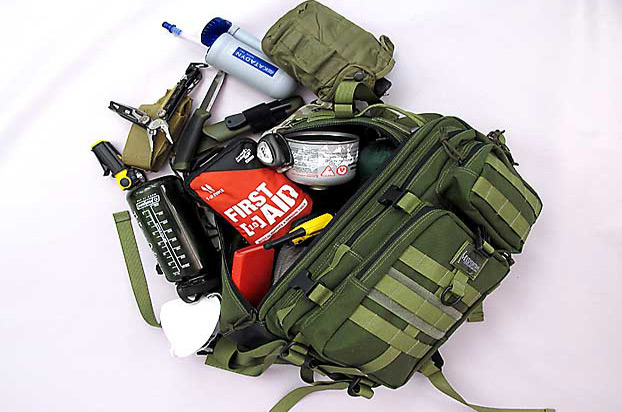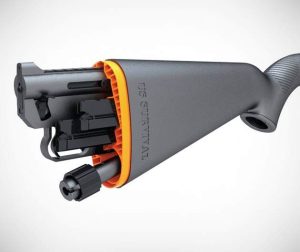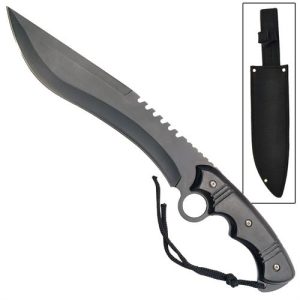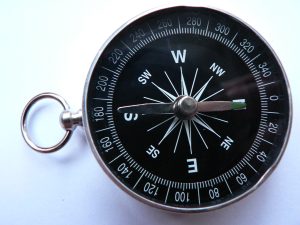Click Here To Join Our Telegram Channel for FREE daily tutorials!

Among survivalists, it’s called a “Go Bag” or “Bug Out Bag”, or just “BOB”, but no matter what you call it, it could be your most essential piece of survival gear.
It is basically a large survival kit that’s filled with everything you need to survive during and after a disaster. Your Bug Out Bag allows you to quickly grab what you need should be forced to get out of dodge in a hurry.
FEMA and the other preparedness agencies of the world will tell you that your Bug Out Bag should have enough supplies to last for at least 72-hours. Since most major disasters will disrupt services and your normal life for a lot longer than three days, it’s best if you have stuff in your Bug Out Bag that will get you by for longer than that. There is, however, only so much you can carry, but The official US Army Survival Manual says even the smallest survival kit if properly prepared, is invaluable when faced with a survival problem.
Your Bug Out Bag should be packed and ready, and easily accessible whenever you should need it. You may want to keep your Bug Out Bag in your car, or your designated “Bug Out” vehicle. Each family member should have their own Bug Out Bag stocked with the baseline essentials, and other more specific items based on their age, gender, and other personal needs.
You need to take your Bug Out Bag with you when hiking, camping and traveling by boat, or any other means of transportation where you may wind up in a survival situation.
How much equipment you put in your kit depends on how you will carry the kit. A kit carried on your body will have to be smaller than one carried in a vehicle. Always layer your Bug Out Bag, keeping the most important items on your body. For example, your knife and compass should always be on your body – or in the most readily accessible pockets of your Bug Out Bag.
List Of The Bug Out Bag Essentials:
Make sure your Bug Out Bag is built to fit your needs; some people may need items that are not on this list.
• Individually sized backpack/rucksack
• Drinking water—(3day supply, minimum 8 oz per person per day)
• Food—nonperishable, easytoprepare items (3day supply, minimum 1200 calories per day)
• Flashlight
• Batterypowered or handcrank/solar multi-band/NOAA weather radio
• Knife
• First aid kit
• Multipurpose tool
• Pocket compass (see tips on how to use)
• 8″ x 10″ plastic tarp
• Emergency blanket
• All weather pocket size sleeping bag
• 36-hour emergency candles
• Whistle
• Flint fire starter & striker
• Stormproof/waterproof matches
• Disposable lighters
• Sunscreen – at least SPF 30
• Dust/bio-hazard mask
• Compact folding stove & fuel tablets
• Portable water filter
• Water purification tablets
• 2.5 gal collapsible water carrier
• Rechargeable batteries (AA/AAA) and solar battery charger
• Heavy duty poncho
• Light rain poncho
• Bio-hazard mask
• Change of clothes and a warm hat
• USB cigarette lighter charger adapter
• Sewing kit
• Waterproof “personal communications pouch” – including permanent marker, paper, tape
• Mirror
• Duct tape
•Compact folding shovel/hatchet/hammer 6-in-1 survival tool
• Pry bar and gas shutoff tool
• Leather work gloves
• 2- 4 light sticks
• Safety goggles
• Sanitation and personal hygiene items
• ¼ inch x 50 ft polypropylene rope
• 50 ft nylon utility cord
• Siphon hand pump
• Map(s) of the area
• This handbook
Essential But Non-emergency/Survival Items For Your Bug Out Bag:
• Extra cash
• Deck of playing cards
• Photos of family members and pets for re-identification purposes
• List of emergency point-of-contact phone numbers
• List of allergies to any drug (especially antibiotics) or food
• Copy of health insurance and identification cards
• Extra prescription eye glasses, hearing aid or other vital personal items
• Sunglasses
• Extra keys to your house and vehicle
Additional Items
Even the best of kits should never be considered “complete.”
The above outline and details are intended to provide you with the Bug Out Bag “baseline essentials”. You will want to customize your Bag to your individual size and physical abilities. You also will want to personalize with individual toiletry or other personal items for men, women, and children etc.
Some additional items you may want to include are:
• Wind Proof Lighter
• Back Pack Signaling Flares
• Walkie-Talkies
• Chemical hand warmers
• Machete
 It is recommended that you only include weapons in your Bug Out Bag, if the situation you are going into dictates it, and only if you have been properly trained in their use. A folding “survival rifle” like the AR-7 used by the US Air Force is a great Bug Out Bag firearm.
It is recommended that you only include weapons in your Bug Out Bag, if the situation you are going into dictates it, and only if you have been properly trained in their use. A folding “survival rifle” like the AR-7 used by the US Air Force is a great Bug Out Bag firearm.
If you are talking about a “survival rifle” in its most literal sense of the word, then it has to be lightweight and easily mobile. At the same time, it must have enough firepower to be capable of procuring food or to offer you protection against a hostile threat.
In my experience, there is none better at that than the AR-7. The AR-7 made by Henry Arms is the civilian available version of the famous U.S. Air Force “floating survival rifle.” The components of the AR-7 breakdown, and all fit into the waterproof stock of the weapon; it becomes small enough to carry in your Bug Out Bag. It is a favorite of bush pilots, boaters, and outdoorsman the world over. It is chambered for .22 long rifle ammo, making the ammunition cheap and plentiful. You can get 500 rounds of .22L for under 20.00. The action is semi-auto, and it takes an 8 round magazine, two of which also fit into the stock. It is ideal to have in your Bug Out Bag for picking off squirrels, rabbits or other small game, and in the hands of a good shooter, adequate for self-defense in an emergency situation. The whole weapon is as light as a feather weighing only 2.5lbs. It will float both when collapsed and when fully assembled. This rifle is also inexpensive and goes for anywhere from $150 used to $250 for the new ones.
Tips and Takeaways
• In addition to packing extra clothes in your Bug Out Bag, the clothes you wear while bugging out are also important. Of course, time of year and the weather have a lot to do with what to wear. But in general, get yourself a good sturdy pair of hiking boots, or military style combat boots. Unless you have reason to be hiding from someone while you are evacuating — and that’s your business – you don’t have to wear camo, but military, or law-enforcement style “cargo pants” with lots of pockets are a good idea. A hunter or camping style vest, again with many pockets, is also a valuable piece of clothing. 5.11 is my favorite provider of tactical clothing.
• Wear a belt, it is useful to hold items that you need to get to quickly, and it also can be used as an improvised rope or fastening device for a number of emergency situations. Be sure it has a heavy buckle, and you do not really need it to hold up your pants, so it can be swung effectively as a bolo type weapon in a pinch.
• Carabineers can be used to hook items that you need to get to easily on the outside of your pack.
• Select items for your bag that you can use for more than one purpose. Do not duplicate items, as this increases your kit’s size and weight.
• If you know nothing about knots and lashing, include some zip ties in your Kit, these have a ton of uses.
• Some say your pack should be a bright color to use as a signaling device if you get lost. I say if you need to Bug Out, the Sh*t has probably hit the fan, and you probably don’t want to be seen, and/or you may be in a situation where you have to hide your stuff. Always think “E&E” – go with a camo military surplus rucksack for your Bug Out Bag. You will have other stuff in it for signaling for help if need be.
The Right Knife
Ever since the movie “Rambo” came out, everybody thinks a “Survival Knife” is this huge piece of steel, with a hollow handle to hold a survival kit. It looks cool in the movies, and you can find them all over the internet. But that’s exactly where they should stay – in the movies and on your computer screens – not in your survival pack!
First of all, that hollow metal or plastic handle that you think is so spiffy is only held on with a simple nut or even a small dab of epoxy glue in the real cheap examples! They can easily break under the kind of abuse a real survival knife needs to be built to take. And about the stuff in that handle – yes it is good stuff to have, but what happens if you lose the knife? Now you are down both a knife and a bunch of useful supplies! You would be better off carrying the water-proof matches, fishing line, etc. that is concealed in the handle, in your pocket, or a small personal kit, or other containers.
Remember the purpose of a knife in your Bug Out Bag is not to be a weapon, but a tool, and you want a knife that was best designed for that purpose, and nothing else. You need to look for a knife that is a “full tang.” This is also sometimes called a “one piece” or “integrated design.”

It means the blade becomes the handle, usually with side pieces attached to both sides for improved grip. How the blade tapers into the handle (or pommel) can differ depending on the model, but the important thing to remember is that you want a single piece of steel. Full tangs are essential for maximum strength and utility. If you have decided to carry a machete as part of your bag, same rules apply.
Stick to name brands in knives or machetes like SOG or Gerber. You will never hear a complaint from someone who spent top-dollar on a survival blade; you probably won’t hear at all from someone who didn’t!
How to Use A Compass
A compass is a Bug Out Bag essential, but it won’t do you squat if you don’t know how to use it, and chances are – you don’t.
Forget more completed orienteering type “map” compasses, they are too complicated for the average user and are designed for sophisticated navigation. You just don’t want to get lost. A good simple camping style pocket compass can be your best friend in a survival situation and requires no special skills to use. Here’s how to use a basic compass.
• Hold the compass flat in the palm of your hand at chest level;
• Move your body around until the Red end of the needle, usually marked with an “N” lines up with the “N” on the face of the compass, now you know which way is North.
Proper Position for Holding Your Compass

So long as you keep the red magnetic needle lined up with the “N” on the compass – you will always be able to get your bearings and know how to travel in any direction you wish. Some simple compasses also have a rotating clear bevel on top with a clear Lucite arrow. These are a good idea if you have never used a compass. With such a compass, once you have identified North as above, and you want to travel east, for example, turn the Lucite arrow so it lines up over the “E”, and head in that direction. Leave the arrow there as a reminder of the direction you want to move in, and every 100 paces or so, realign the red compass needle to the North, to be sure you are moving in the desired direction.
Last Word
Your Bug Out Bag is critically important, but only as a vital tool that will help you survive. Never forget that YOU are still your best and most ULTIMATE survival tool. It is your confidence, your skills, your knowledge, and your will to survive that will be the biggest determining factor of whether you will make it or not.
By James Durr, Contributor of www.myfamilysurvivalplan.com
This Crazy Off Grid Device Literally Makes Drinkable Water From Fresh Air:
According to NASA, the U.S. is expecting a 100-YEAR LONG MEGADROUGHT.
It's already begun. Ask the farmers in California. They know.
Every survivalist knows that water is of critical importance. You NEED an independent water source that you can count on!
As an interesting "survival rehearsal" - imagine that you turned the tap on right now and nothing came out. How long would you last?
But what if there was another water source literally hidden in plain sight. That's right, I'm talking about the atmosphere!
The amazing thing about getting water from the natural moisture in the air... is that it is ALWAYS available.
This gives you real water security!
Learn more about how to tap into "Nature's secret water reservoir" and stay hydrated when TSHTF!
Watch the video:
😳 What Tinnitus Does To Your Brain Cells (And How To Stop It)
After 47 years of studies and countless brain scans done on more than 2,400 tinnitus patients, scientists at the MIT Institute found that in a shocking 96% of cases, tinnitus was actually shrinking their brain cells.
As it turns out, tinnitus and brain health are strongly linked.
Even more interesting: The reason why top army officials are not deaf after decades of hearing machine guns, bombs going off and helicopter noises…
Is because they are using something called "the wire method", a simple protocol inspired by a classified surgery on deaf people from the 1950s...

I Can't Help Showing This Off:
If you haven't heard of Claude Davis yet do yourself a huge favor and watch this video.
One of the smartest guys I ever had the pleasure of meeting, Claude set-up a unique prepping system that changed his life forever.
I already tried it myself and let me tell... you I was completely blown away... His surprising tactics could make your life easier and give you the peace of mind you deserve.
Don't just take my word for it... watch his short video and decide for yourself.

Most People Don't Have The Guts To Try This:
An amazing discovery in an abandoned house in Austin, Texas: A lost book of amazing survival knowledge, believed to have been long vanished to history, has been found in a dusty drawer in the house which belonged to a guy named Claude Davis.
Remember... back in those days, there was no electricity... no refrigerators... no law enforcement... and certainly no grocery store or supermarkets... Some of these exceptional skills are hundreds of years of old and they were learned the hard way by the early pioneers.
>> Click here to find out about them now
We've lost to history so much survival knowledge that we've become clueless compared to what our great grandfathers did or built on a daily basis to sustain their families.
Neighbors said that for the last couple of years Claude has tried to unearth and learn the forgotten ways of our great-grandparents and claimed to have found a secret of gargantuan proportions. A secret that he is about to reveal together with 3 old teachings that will change everything you think you know about preparedness:
>>> Click Here To Watch His Short Video <<<

More Off-Grid And Survival Resources:

What REALLY Happens When You Bury a Shipping Container? (Hint: It's A Bit Crazy...)
Shipping containers are all the rage - but if you are thinking about buying one, you MUST watch this video first:
There's a general belief that if you bury a shipping container you can create an awesome root cellar / storm shelter / survival bunker.
But is a shipping container strong enough to handle the pressure?
Watch the video to see what happens:
What Really Happens When You Bury a Shipping Container? (Click To Watch Video)










This is the first bug out bag list I have seen. I find it very interesting but, as a 79 year old woman, I doubt I would be able to lift, much less carry it some distance. The multi-pocket garments could be packed ahead of time with much of this in pockets so one could simply dress and go. The back pack could then be much lighter and also have some extra space for items that might be found as you go. As for me, just food and water might be my weight limit.
You make no suggestions as to food. my own preferences would lean toward dried foods that can be eaten without reconstituting :nuts, fruits, meat and fish. Minimum packaging needed and can be eaten on the move, pocket food. Chewing gum could be invaluable to postpone thirst and hunger with minimal weight but is not on your list. Water is heavy and calories are required. Some water might be in the form of fruit or vegetable juice. Something like V-8 can be a great soup base for foraged wild edibles.
Really, at this stage of the game we are still teaching people how to do a BOB. Really! God help us.
A search and rescue organization I am involved with requires 2 bags. A 24 hour bag and a 48 hour bag. Interesting concept.. On a mission, take both and according to the assignment, usually end up carrying the lighter one since we hardly ever stay out longer than 24 hours. For a true bug-out situation, I would probably pack the empty small backpack inside the large bag to carry for excursions away from my base. Also, in addition to the space blanket, They also sell a mylar bag plenty big enough for 2 sleeping bags. If no shelter, bad weather or a forest fire, this could save your life.
For weapons, I do have an AR-7 and machete, (machete may be more valuable, because with it I can make weapons after ammo runs out) but for the small bag I only take a powerful slingshot and a small bag of toy marbles. (Also easy to get thru scanners). It will get a rabbit or squirrel and perhaps deter an unarmed thief or bully, or just to pass time doing target practice. Another easily carried silent hunting weapon is a blowgun and darts. My son could easily kill pigeons off the building next door with one.